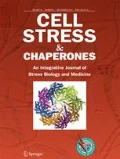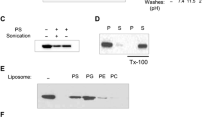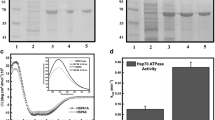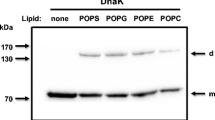Abstract
The successful function of cells is importantly contributed by lipid membranes that are more than a simple physical barrier. The major components of cellular membranes are lipids, in particular glycerophospholipids, that have the capacity to assemble spontaneously into vesicles containing a lipid bilayer after exposure to an aqueous milieu due to their amphiphilic characteristics. The lipid capacity to form vesicles and encapsulate substrates has been proposed as a fundamental event during the biogenesis of cells. However, the stability of small vesicles is compromised during their expansion into larger and more complex particles. Recent observations by (Cornell et al. Proc Natl Acad Sci U S A 116:17239–17244, 2019) have shown that the insertion of amino acids into rudimentary vesicles could play a stabilizing role that was critical to the formation of early cells. Fatty acids were likely substituted by glycerophospholipids and amino acids replaced by polypeptides during the evolution of protocells. Thus, archaic peptides displaying lipid-binding and membrane-penetrating capacities could have played a key function in the development of current cells. In this regard, heat shock proteins (HSP), particularly the Hsp70 (HSPA) and small HSP (HSPB) families, could have portrayed that role. Indeed, bacterial DnaK is closest in sequence to the earliest members of the Hsp70 family and inserts into lipid membranes spontaneously. Moreover, extensive studies by the Vigh group have shown that, certainly, Hsp70s stabilize membranes. Thus, the ability of ancestral HSP70s and small HSPs to associate with lipids and stabilize membranes could have been a fundamental event in the genesis of cells.
Similar content being viewed by others
References
Alder GM, Austen BM, Bashford CL, Mehlert A, Pasternak CA (1990) Heat shock proteins induce pores in membranes. Biosci Rep 10:509–518
Arispe N, De Maio A (2000) ATP and ADP modulate a cation channel formed by Hsc70 in acidic phospholipid membranes. J Biol Chem 275:30839–30843
Arispe N, Doh M, Simakova O, Kurganov B, De Maio A (2004) Hsc70 and Hsp70 interact with phosphatidylserine on the surface of PC12 cells resulting in a decrease of viability. FASEB J 18:1636–1645
Armijo G, Okerblom J, Cauvi DM, Lopez V, Schlamadinger DE, Kim J, Arispe N, de Maio A (2014) Interaction of heat shock protein 70 with membranes depends on the lipid environment. Cell Stress Chaperones 19:877–886
Balogi Z, Multhoff G, Jensen TK, Lloyd-Evans E, Yamashima T, Jäättelä M, Harwood JL, Vígh L (2019) Hsp70 interactions with membrane lipids regulate cellular functions in health and disease. Prog Lipid Res 74:18–30
Black RA, Blosser MC (2016) A self-assembled aggregate composed of a fatty acid membrane and the building blocks of biological polymers provides a first step in the emergence of protocells. Life (Basel) 6:33
Casares D, Escriba PV, Rossello CA (2019) Membrane lipid composition: effect on membrane and organelle structure, function and compartmentalization and therapeutic avenues. Int J Mol Sci 20:2167
Cobb BA, Petrash JM (2002) Alpha-crystallin chaperone-like activity and membrane binding in age-related cataracts. Biochemistry 41:483–490
Cornell CE, Black RA, Xue M, Litz HE, Ramsay A, Gordon M, Mileant A, Cohen ZR, Williams JA, Lee KK, Drobny GP, Keller SL (2019) Prebiotic amino acids bind to and stabilize prebiotic fatty acid membranes. Proc Natl Acad Sci U S A 116:17239–17244
Damer B, Deamer D (2015) Coupled phases and combinatorial selection in fluctuating hydrothermal pools: a scenario to guide experimental approaches to the origin of cellular life. Life (Basel) 5:872–887
De Maio A, Cauvi DM, Capone R, Bello I, Egberts WV, Arispe N, Boelens W (2019) The small heat shock proteins, HSPB1 and HSPB5, interact differently with lipid membranes. Cell Stress Chaperones 24:947–956
Dores-Silva PR, Cauvi DM, Coto ALS, Kiraly VTR, Borges JC, De Maio A (2020a) Interaction of HSPA5 (Grp78, BIP) with negatively charged phospholipid membranes via oligomerization involving the N-terminal end domain. Cell Stress Chaperon 1–13. https://doi.org/10.1007/s12192-020-01134-9
Dores-Silva PR, Cauvi DM, Kiraly VTR, Borges JC, De Maio A (2020b) Human HSPA9 (mtHsp70, mortalin) interacts with lipid bilayers containing cardiolipin, a major component of the inner mitochondrial membrane. Biochim Biophys Acta Biomembr 1862:183436
Guidon PT Jr, Hightower LE (1986a) Purification and initial characterization of the 71-kilodalton rat heat-shock protein and its cognate as fatty acid binding proteins. Biochemistry 25:3231–3239
Guidon PT Jr, Hightower LE (1986b) The 73 kilodalton heat shock cognate protein purified from rat brain contains nonesterified palmitic and stearic acids. J Cell Physiol 128:239–245
Harayama T, Riezman H (2018) Understanding the diversity of membrane lipid composition. Nat Rev Mol Cell Biol 19:281–296
Horvath I, Multhoff G, Sonnleitner A, Vigh L (2008) Membrane-associated stress proteins: more than simply chaperones. Biochim Biophys Acta 1778:1653–1664
Kirkegaard T et al (2010) Hsp70 stabilizes lysosomes and reverts Niemann-pick disease-associated lysosomal pathology. Nature 463:549–553
Leventis PA, Grinstein S (2010) The distribution and function of phosphatidylserine in cellular membranes. Annu Rev Biophys 39:407–427
Lopez V, Cauvi DM, Arispe N, De Maio A (2016) Bacterial Hsp70 (DnaK) and mammalian Hsp70 interact differently with lipid membranes. Cell Stress Chaperones 21:609–616
Macazo FC, White RJ (2014) Monitoring charge flux to quantify unusual ligand-induced ion channel activity for use in biological nanopore-based sensors. Anal Chem 86:5519–5525
Multhoff G, Hightower LE (1996) Cell surface expression of heat shock proteins and the immune response. Cell Stress Chaperones 1:167–176
Ritossa F (1962) A new puffing pattern induced by temperature shock and DNP in Drosophila. Experientia 18:571–573
Schilling D, Gehrmann M, Steinem C, de Maio A, Pockley AG, Abend M, Molls M, Multhoff G (2009) Binding of heat shock protein 70 to extracellular phosphatidylserine promotes killing of normoxic and hypoxic tumor cells. FASEB J 23:2467–2477
Segre D, Ben-Eli D, Deamer DW, Lancet D (2001) The lipid world. Orig Life Evol Biosph 31:119–145
Tanford C (1978) The hydrophobic effect and the organization of living matter. Science 200:1012–1018
Tjondro HC, Xi YB, Chen XJ, Su JT, Yan YB (2016) Membrane insertion of alphaA-crystallin is oligomer-size dependent. Biochem Biophys Res Commun 473:1–7
Tsvetkova NM et al (2002) Small heat-shock proteins regulate membrane lipid polymorphism. Proc Natl Acad Sci U S A 99:13504–13509
Vega VL et al (2008) Hsp70 translocates into the plasma membrane after stress and is released into the extracellular environment in a membrane-associated form that activates macrophages. J Immunol 180:4299–4307
White SH, Wimley WC (1998) Hydrophobic interactions of peptides with membrane interfaces. Biochim Biophys Acta 1376:339–352
Acknowledgments
We would like to thank our collaborators Peter T. Guidon, Jr., Nelson Arispe, Paulo R. Dores-Silva, and David M. Cauvi, for their productive discussions. I (ADM) would like to recognize that this work is the product of many years of interest in cellular membranes that was sparked by Prof. Fracehulli Dagger while I was an undergraduate student in my original country, Venezuela. The editorial assistance of Barbara Rho is praised.
Author information
Authors and Affiliations
Corresponding author
Additional information
Publisher’s note
Springer Nature remains neutral with regard to jurisdictional claims in published maps and institutional affiliations.
Rights and permissions
About this article
Cite this article
De Maio, A., Hightower, L.E. Heat shock proteins and the biogenesis of cellular membranes. Cell Stress and Chaperones 26, 15–18 (2021). https://doi.org/10.1007/s12192-020-01173-2
Received:
Revised:
Accepted:
Published:
Issue Date:
DOI: https://doi.org/10.1007/s12192-020-01173-2




